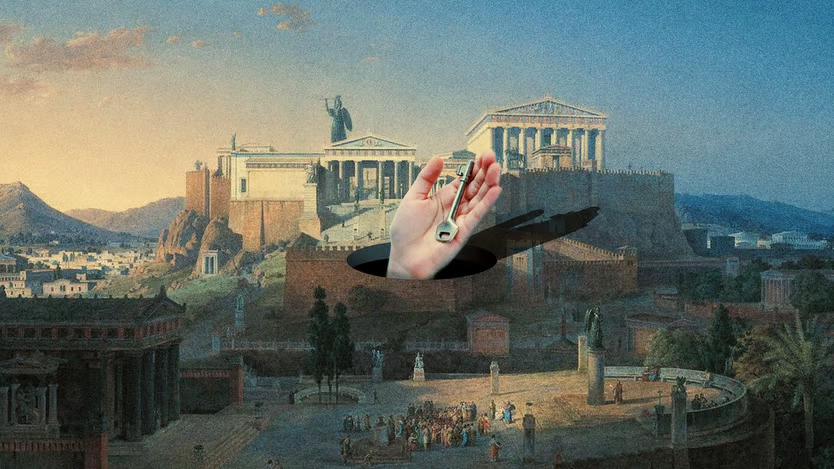The greatest civilisations of the past 3,000 years were the opposite of MAGA

May 1st 2025ShareListen to this story
Peak Human. By Johan Norberg. Atlantic Books; 400 pages; $32.99 and £22
The way to start a “golden age” is to erect big, beautiful barriers to keep out foreign goods and people. That, at least, is the view of the most powerful man on the planet. Johan Norberg, a Swedish historian, makes the opposite case. In “Peak Human”, Mr Norberg charts the rise and fall of golden ages around the world over the past three millennia, ranging from Athens to the Anglosphere via the Abbasid caliphate. He finds that the polities that outshone their peers did so because they were more open: to trade, to strangers and to ideas that discomfited the mighty. When they closed up again, they lost their shine.
Consider the Song dynasty in China, which lasted from 960 to 1279AD. Song emperors were much keener on the rule of law than their predecessors, who tended to rule by whim. To enforce predictable rules, they hired lots of officials via meritocratic exams. The first Song emperor enacted the “unconventional policy reform” of “[not] killing officials who disagreed with him”.
Peasants were granted property rights and allowed to move around, rather than being tied to a lord’s land. Farm output more than doubled, and the extra food supported much larger cities. In the 1100s Kaifeng, the capital, had 65 times the population of London. Canals made domestic trade easier. International trade followed. Merchants started issuing paper money, six centuries before Europeans did, and the government embraced this brilliant idea—so much easier than carrying heavy strings of copper coins.
“Crowded cities set the stage for an unparalleled exchange of ideas, goods [and] services,” notes Mr Norberg. Artisans devised new industrial processes, such as burning coal to smelt iron. The invention of movable type in the 1040s allowed the printing of books so cheap that one philosopher griped that people would stop learning the classics by heart. By 1200 Song China had the world’s richest economy, a merchant navy with “the potential to discover the world” and a habit of tinkering that could have brought on an industrial revolution centuries before Europe’s. But then the Mongols arrived.
The popular image of Genghis Khan and his mounted hordes sweeping across the world slaughtering and burning is accurate as far as it goes. However, the Mongol dynasty took pains to preserve its predecessor’s technological marvels—even if it did not add much to them. It was only when the Ming emperors took over in 1368 that China really turned in on itself.
Free movement within the country was ended. Free exchange gave way to forced labour. Foreign trade was made punishable by death, and even the construction of ocean-worthy ships was banned. Pining for the good old days, a Ming emperor brought back the fashions of 500 years before. Men caught with the wrong hairstyle were castrated, along with their barbers. Largely thanks to reactionary Ming policies, Chinese incomes fell by half between 1080 and 1400. The country did not recover its mojo until it opened up again in the late 20th century.
Some of the golden ages Mr Norberg describes will be familiar to readers, but he adds fresh details and provocative arguments. Athens was not just the birthplace of democracy; it grew rich because it was, by ancient standards, liberal. Tariffs were only 2%. Foreigners were welcome: a Syrian ex-slave became one of the richest men in town. On a measure devised by the Fraser Institute, a Canadian think-tank, ancient Athenians enjoyed more economic freedom than citizens of any modern nation, narrowly beating Hong Kong and Singapore. (Such freedom did not apply to women or slaves; a caveat that applies to all golden ages until relatively recently.)
Rome grew strong by cultivating alliances and granting citizenship to conquered peoples. It learned voraciously from those it vanquished—Greek slaves taught Roman children about logic, philosophy and drama. During Rome’s golden age, one set of laws governed a gigantic empire, markets were relatively free and 400,000km of roads sped goods from vessel to villa. As a gobsmacked Greek orator put it: to see all the world’s products, either travel the world or come to Rome.
The emperor Augustus introduced a flat poll tax and a modest wealth tax. Extra income from hard work or innovation suddenly faced a marginal tax rate of zero. Small wonder Augustan Rome grew as rich as Britain and France were 1,500 years later.
Mike Johnson, the Republican speaker of America’s House of Representatives, thinks Rome collapsed because of “rampant homosexual behaviour”. Mr Norberg offers a more convincing explanation. Bad luck—plagues and barbarian attacks—was compounded by policy blunders.
Cash-strapped emperors debased the coinage, reducing its silver content. This caused wild inflation. Price controls were then slapped on everything “from sandals to lions”. Trade atrophied.
Intellectual freedom gave way to dogma, with the persecution first of Christians and then by Christians. Finally, Rome was too weak to resist the barbarian onslaught. Revisionists say the Dark Ages that followed were not so bad. Archaeological evidence, such as a sudden fall in the number of cargo-ship wrecks, suggests they were “the biggest social regression in history”.
Mr Norberg deftly punctures popular misconceptions. The zealots of Islamic State revere the Abbasid caliphate, but would have hated its tolerance. The Italian Renaissance, which modern nationalists such as Viktor Orban see as evidence of European and Christian cultural superiority, began as a revolt against Christian orthodoxy and in imitation of pagan cultures. Despite what you read in Blake and Dickens, Britain’s Industrial Revolution was not miserable for the workers: a study of diaries shows the only group consistently dissatisfied was poets and writers.
Could a history book be more timely? Of all the golden ages, the greatest is here and now. Of all the progress of the past 10,000 years in raising human living standards, half has occurred since 1990. Openness went global after the collapse of the Soviet Union. But now it is in rapid retreat, as a multilateral trade war looms and ever more states suppress free inquiry.
Previous golden ages all ended like Rome’s did, jinxed by a mix of bad luck and bad leadership. Many thriving societies isolated themselves or suffered a “Socrates moment”, silencing their most rational voices. “Peak Human” does not mention Donald Trump; it was written before he was re-elected. America’s president will not read it, but others should. The current age of globalisation could still, perhaps, be saved. As Mr Norberg argues: “Failure is not a fate but a choice.”

